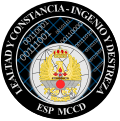| Mando Conjunto del Ciberespacio | |
 Joint Cyberspace Command emblem | |
| Intelligence agency overview | |
|---|---|
| Formed | February 19, 2013 |
| Headquarters | Retamares Base, Madrid, |
| Motto | Lealtad y constancia. Ingenio y Destreza. (Loyalty and constancy. Ingenuity and Dexterity) |
| Intelligence agency executive |
|
| Parent Intelligence agency | Defence Staff |
| Website | www.emad.mde.es |

The Joint Cyberspace Command (MCCE), known until 2020 as Joint Cyber-Defence Command (MCCD), is a Spanish cyberspace service of the Defence Staff responsible for planning and carrying out the actions related to cyber defence in networks and information and telecommunications systems of the Ministry of Defense or others that might be entrusted, as well as contributing to the adequate response in cyberspace to threats or aggressions that may affect to the National Defense. [1]
Contents
In this sense, the MCCD directs and coordinates, in the matter of cyber defense, the activity of the centers of response to incidents of security of the information of the different branches of the Armed Forces; it exercises the timely, legitimate and proportionate response in cyberspace to threats or aggressions that may affect the National Defense and defines, directs and coordinates awareness, training and specialized training in this area. In addition, he is responsible for the development and detail of the Information Security policies in the Information and Telecommunications Systems (SEGINFOSIT) and the direction of execution and control of compliance with these policies, within the scope of the Ministry of Defense. [2]
The MCCD was created on February 19, 2013 by a Defence Ministry Order 10/2013, by which the Joint Cyber-Defence Command is created. In 2020, it was renamed Joint Cyberspace Command. The current Chief Commander of the MCCD is vice admiral Francisco Javier Roca Rivero.


